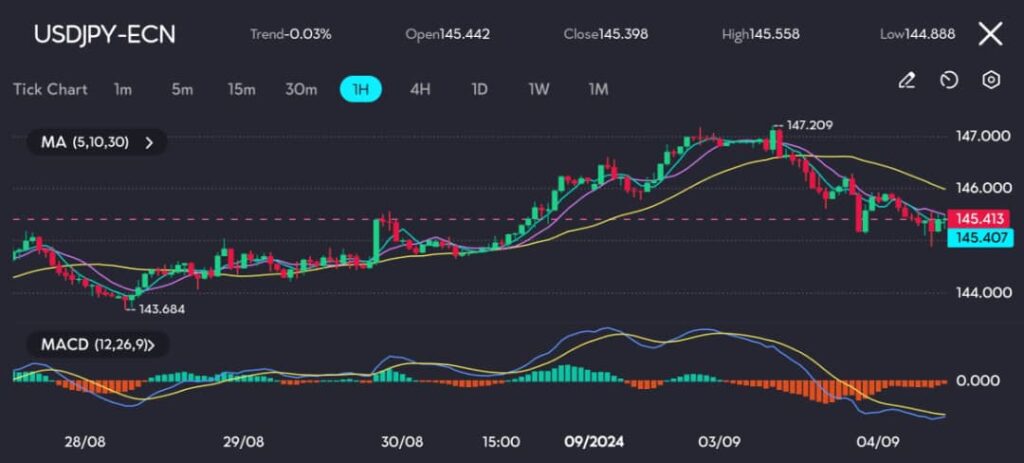Key points:
- The Japanese yen gained 0.3%, strengthening to 145.02 per dollar.
- Traders anticipate the U.S. payroll report to show an increase of 165,000 jobs, up from July’s 114,000.
Global financial markets shifted into risk-off mode on Wednesday as the Japanese yen gained strength and risk-sensitive currencies like the Australian dollar and British sterling weakened. These movements followed a sharp sell-off in U.S. equities, driven by weaker-than-expected manufacturing data.
The soft figures heightened concerns about the U.S. economy’s ability to achieve a soft landing, with upcoming payroll data adding further uncertainty.
Yen rises amid declining U.S. Treasury yields
By early Asian trading hours, the yen had strengthened by 0.3%, reaching 145.02 per dollar, continuing its upward trend from the previous session when it rallied 1%.
The currency’s performance was supported by a decline in U.S. Treasury yields, which dropped nearly 7 basis points to 3.8329%, as investors sought the relative safety of bonds.
Picture: Japanese yen on the rise, trading at 145.413 on the VT Markets app.
The charts paint a similar narrative. The USD/JPY currency pair has shown some signs of retreat, closing at 145.39 after reaching a high of 145.55. This weakening of the dollar against the yen is notable, particularly as it contrasts with the dollar’s relative stability against other major currencies, where it maintained its position as a safe-haven asset.
The technical indicators, including the MACD, suggest a potential shift in momentum as the MACD histogram turns more negative. Additionally, the moving averages are signaling caution, with a potential cross forming that could indicate further declines for the USD/JPY.
Traders will likely watch the next few sessions closely to determine if this decline is a temporary pullback or the beginning of a more prolonged downward trend, especially considering broader macroeconomic events.
Other markets performance
Sterling declined to $1.3110, reflecting a 0.23% drop, while the euro saw a slight recovery to $1.10495 after a previous 0.26% decline.
The Australian dollar, often sensitive to risk sentiment and commodity prices, continued its slide, falling 0.15% to $0.67015. This extended its losses from Tuesday when it dropped by 1.2%, further highlighting the cautious sentiment in the markets.
U.S. jobs data in focus as Fed rate cut expectations rise
Investors are now turning their attention to key U.S. economic data, with the payroll report due on Friday expected to influence the Federal Reserve’s upcoming policy decisions.
The probability of a 50 basis point rate cut by the Fed at its September 18 meeting has risen to 38%, up from 30% the previous day. The outlook for U.S. jobs data will play a pivotal role in shaping market expectations for future interest rate movements.
Economists are forecasting a rise of 165,000 jobs in August, compared to a gain of 114,000 in July. Ahead of Friday’s release, market participants will monitor job openings data on Wednesday and jobless claims on Thursday for further indications of labour market conditions.
In case you missed: Dollar holds steady as markets anticipate U.S. payrolls report
Weak U.S. manufacturing data heightens fears of economic slowdown
The weaker-than-anticipated U.S. manufacturing data has compounded concerns that the Federal Reserve may be behind in addressing the economic slowdown.
The Institute for Supply Management (ISM) reported a contraction in factory activity, a surprise to many expecting a modest improvement. In August, economic activity in the manufacturing sector contracted for the fifth consecutive month and for the 21st time over the past 22 months, highlighting ongoing weakness in the industry. This has added further uncertainty to an already jittery market environment.
Despite the shortened trading week due to the Labour Day holiday, the upcoming economic reports are expected to play a crucial role in shaping investor sentiment in the near term. Markets are likely to remain cautious, with risk aversion continuing to influence currency and bond markets as the week progresses.
Start trading now — click here to create your live VT Markets account.








